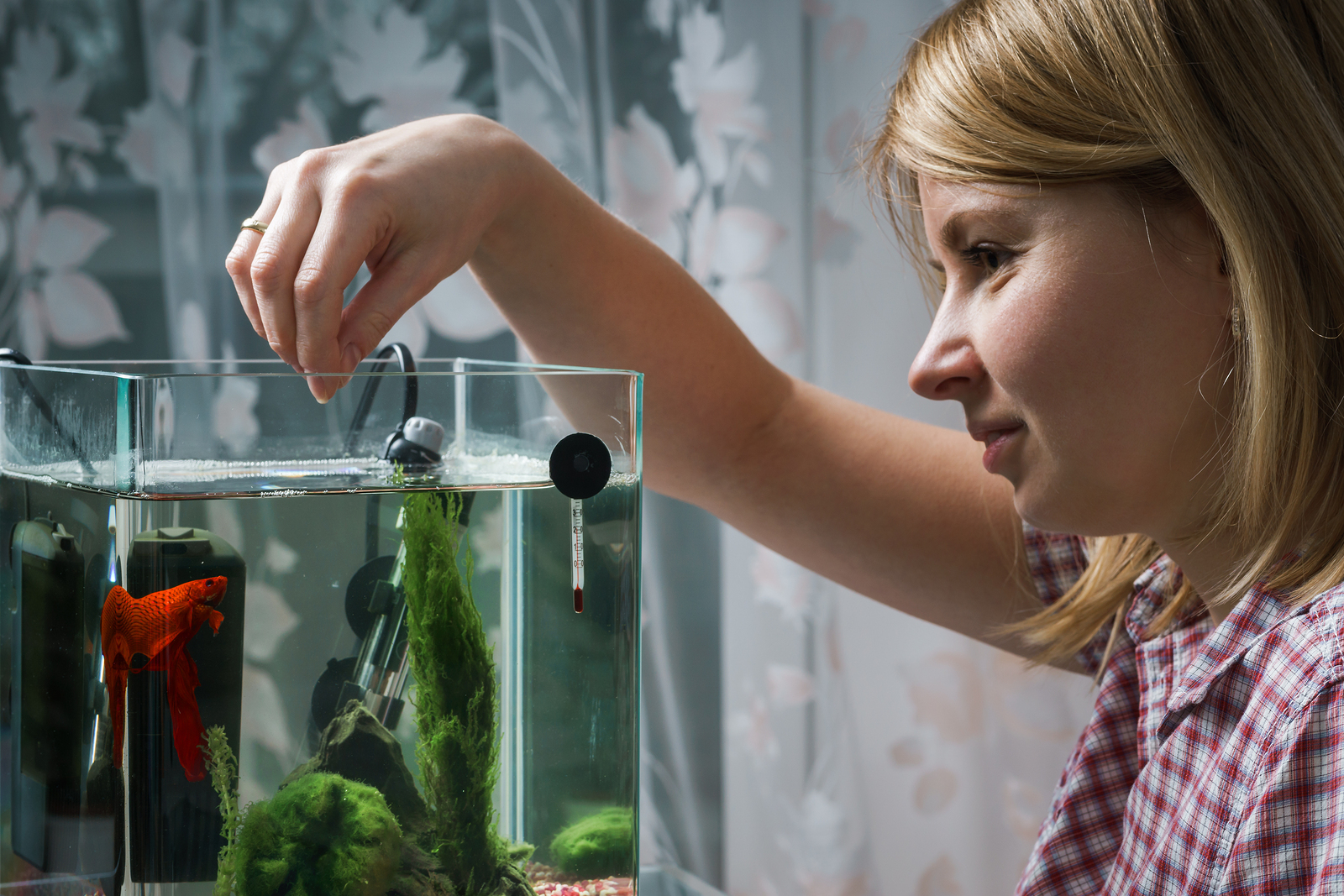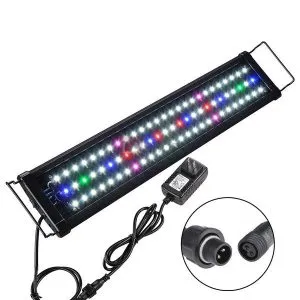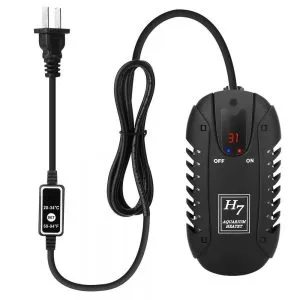Saltwater Tank Setup Checklist

When you are setting up your saltwater fish tank, you should aim, if possible, to simulate the conditions that your fish enjoy in their wild habitat. For example, shy; nocturnal fish will want some rocks to hide behind, whereas other, more adventurous fish will need plenty of open water.
What Do You Need for a Saltwater Tank?
That’s easy, you need information! Get informed before a drop of water hits the aquarium. Decide what type of saltwater aquarium you want. Is it going to be fish only, coral only or a full reef aquarium? Your decisions will determine what type of equipment and lighting you will need.
Two of the major mistakes I made when I setup my saltwater aquarium was assuming saltwater tanks were similar to freshwater along with not doing enough reading on what supplies were required in order to be successful.
To keep you from making the same mistakes, the following checklist of supplies are what I have found to be must-have supplies in order to have a successful and healthy aquarium from the start:
Saltwater Tank Setup Checklist
Water
The water you use for filling the aquarium will vary according to the area in which you live; for instance, it may be soft or hard, acid or alkaline. Testing kits are available from specialist aquarist shops to help you check the quality of the water for hardness and for pH (the degree of acidity or alkalinity).
Chlorine levels vary, too, and these can affect your fish. Before introducing any fish to your aquarium, you must allow the water in the tank to stand for a few days so that the chlorine escapes.
For some fish, rainwater is preferable. Make sure that it is collected in a clean container and, again, allow it to stand for several days before putting it into the tank. Usually, rainwater is softer than domestic water.
Remember, too, that in a heated aquarium - even one with a lid on - water constantly evaporates. Evaporation will concentrate the minerals in the water and each time you top up the tank, especially with tap water, the mineral concentration will increase. For this reason, the regular replacement of, say, 10-15 per cent of the water in the tank every two or three weeks with previously conditioned water will keep dissolved mineral content down to a safe level.
A close-fitting cover-glass will also help to minimize evaporation losses and prevent condensation damage to the aquarium lighting.
[su_divider top=“no” size=“2” margin=“20”]
A large tank
If you are new to saltwater, having a large tank will have a tremendous impact on your success. A large tank size is more forgiving of mistakes, and when things do go bad they don’t go bad as quickly as a smaller tank. If you’re in doubt about this, check our comprehensive guide on Saltwater Fish Tank Size.
Saltwater fish tanks come in a wide range of types and designs, to suit all tastes and pockets. They are made in various combinations of materials, such as Perspex or glass, with or without iron frames. The lightest modern aquaria are made of glass which is sealed with silicone glue.
Do remember that a tank full of water is extremely heavy, so it is very important to make sure that the bottom of even a lightweight aquarium is always fully supported on a firm base.
Unless you need an aquarium for a specialized purpose, such as an infirmary or as a rearing or quarantine tank, never get one less than 45 cm (1 8 in) long, 30 cm (1 2 in) wide and 30 cm (1 2 in) deep. As a general rule, no measurement should ever be less than the depth. Bow-fronted aquariums cost a lot more than the rectangular ones and do little to enhance the quality of life for the fish.
Avoid overcrowding
To work out how many fish may be kept safely in an unaerated tank, the rule is 2.5 cm (1 in) of fish body length (excluding tails] for every 75 sq cm (1 2 sq in) of water surface area. Thus a 60 x 30 x 30 cm (24 x 1 2 x 1 2 in) tank has a surface area of 1 800 sq cm (288 sq in) and can accommodate 60 cm (24 in) of fish. Note thai the tank depth is immaterial in such calculations
Aeration
Although aeration will greatly increase the tank’s fish-holding capacity, you should never make its use an excuse to overstock the aquarium; suffocation of your fish will occur if the aerator fails.
Positioning the tank
It is best to keep an aquarium away from extremes of temperature and also out of continuous bright light, so a window sill is not a good place to site it. Look for a spot away from direct sunlight or a room heater - an alcove beside a chimney breast is often a good place.
A tank 60 cm (24 in) long and 30 cm (12 in) wide is a good size for a novice. Although a depth of water of 38 cm {14 in) makes for a more pleasing ‘picture’ than 30 cm (1 2 in) and gives the fish more swimming room, the deeper tank cannot hold any more fish as the important criterion is the amount of water surface area, which is the same for both tanks.
This isn’t to say that you can’t be successful with a smaller tank, just that you’ll be far more successful with larger saltwater tanks. This is particularly true when you are new to the hobby and first starting out.
The smaller the fish tank, the more maintenance and experience required. I would suggest starting with at least a 30 gallon tank, and preferably a 55 or larger. You can read more about the benefits of larger tank in my recent article saltwater tank size.
[su_divider top=“no” size=“2” margin=“20”]
A Protein Skimmer
When I started my saltwater tank, I didn’t even know what a protein skimmer was!
Big mistake.
A protein skimmer is a device that either sits in your sump or hangs on the side of your tank.
A protein skimmer removes organic compounds from the water before they break down into harmful byproducts. Protein skimmers out of any piece of equipment, have probably had the single biggest positive impact on saltwater quality and maintain pristine and incredibly clean water.
There are two types of skimmers: skimmers that sit in a sump and skimmers that hang on the back of your tank. While sumps are highly beneficial, they are a bit complex for the beginner. A better and more affordable option is a hang on skimmer. These hang on the back of your aquarium.
One thing you will quickly learn about saltwater aquarium supplies is that you often get what you pay for. I made the mistake of buying a cheap skimmer from the local chain pet store and while it worked, it didn’t work well at all.
After reading many saltwater aquarium forums, I found that the AquaMaxx HOB 1.5 to be reasonably priced and really gets the job done. The Remora comes highly recommended. While not the cheapest item, it is money well spent.
Important Tip: Keeping the collection cup of your skimmer clean and empty is important to the efficiency of your aquarium. You should dump and clean the collection cup out daily. Also import is proper adjustment. Your cup contents should be dark in color, like a strong tea. If it is too watery, you are skimming too wet and should adjust the cup higher.
[su_divider top=“no” size=“1”]
Proper Lighting

Whether you are keeping a fish or reef aquarium, proper lighting plays a key role in the health of your fish. This is particularly true for a reef aquarium where you’ll have lots of corals and invertebrates. For fish only aquariums, a standard florescent fixture with Reef Sun or similar bulb with saltwater hood will work fine.
For a small aquarium, an ordinary 60-watt bulb may be sufficient for illumination. However, fluorescent tube lights are now available, the gas content of which is designed specifically to produce light that is beneficial to plant growth and to enhance the colors of the fish.
You should always avoid using stark bright lights, however, and remember that, in their natural state, tropical fish like subdued lighting or shade. Remember, too, that an ordinary light bulb, unlike a fluorescent tube light, will increase the water temperature. Fluorescent lights are ‘cold’ lights and therefore a better choice. You will need the right starter unit for the size of tube used.
Reef aquariums require far more sophisticated lighting.
Proper lighting is required for corals and invertebrates to survive. Corals and most invertebrates require special lighting for photosynthesis in order to generate energy (similar to your plants).
Corals and invertebrates that don’t get proper lighting will not survive. Given the expense of the various corals and invertebrates, it pays to invest in good quality lighting.
The types of corals you plan to keep will drive the lighting requirements you will need. VHO (Very High Output) and PC (Power Compact) fluorescent lighting systems are best for corals with low to medium lighting requirements. Examples of these are leather corals, mushrooms, and LPS (large-polyped stony) corals.
Metal Halide lighting is best for corals that require more intense lighting requirements, such as SPS (small-polyped stony) corals, anemones, and clams.
The best option in my opinion is a combined lighting system that contains both types and ads blue LED lighting for simulating moon light. While not the best quality light, a very low priced and decent unit is sold by Aquatraders.
Many people have had mixed success with these hoods, but mine has worked well thus far. I use the different lights in the system to simulate dawn to dusk lighting.
RO/DI water filter
High quality water is essential in a saltwater aquarium. I made the mistake of assuming the same water principles apply to saltwater as freshwater.
Wrong!
Think about it, the ocean is huge. As a result, changes to the water conditions such as temperature, Ph, salinity, etc. don’t happen often, and when they do, they are very gradual. Ocean water is also very pure and clean and as a result, the fish and corals require living in very similar conditions. To cut to the chase, you can’t use de-chlorinated tap water like you can with a freshwater aquarium.
Instead, you need to use water from an RO/DI (RO = Reverse Osmosis, DI=De-ionizing) water filter. I purchased a 100GPD unit on eBay for $63.99 plus shipping.
Another option is to purchase this water from our local fish store. It generally runs $.50 to $1.00 per gallon. At these prices, you will pay for the RO/DI water filter after 60 - 100 gallons or so. Given you should change 10%-15% of your water weekly, having your own fish tank filter can be a significant long term saving.
Worried about installation? Don’t be. Most aquarium filtration systems are easy to install and come with various options depending on the location and type of hook-ups you have.
[su_divider top=“no” size=“1”]
A Quality Fish Tank Heater

Unlike warm-blooded humans, fish are ectothermic, meaning they take on the temperature of the surrounding water. Since they can’t maintain the body temperature at a chosen fixed level, the temperature must be maintained through a heater.
Heaters are only necessary if you keep tropical fish rather than marine fish. Coldwater fish like goldfish or koi prefer cooler temperatures (68º - 72º F) and don’t need a heater.
Tropical fish are warm water fish, meaning they like to have their water between 75º F and 79º F. Heaters can help maintain this constant water temperature. Fluctuating water temperatures will cause stress on the fish, which will lead to a number of infections, and even death.
There are two types of aquarium heaters: A “hang-on” style heater and a submersible heater. A “hang-on” style heater provides basic heating of the water. Because the heater is not fully submerged in the water, it is less efficient than a fully submersible heater. Also because “hang-on” style heaters are generally less expensive, they have less precise controls and have fewer operating features.
A submersible heater actually attaches to the inside of the aquarium (typically with suction cups) and the entire heater is positioned under the water. Because the entire heating tube is under the water a submersible heater is more efficient and provides a more consistent temperature.
The rule of thumb when buying a heater is 5 watts for each gallon the aquarium holds. Typically, one heater is sufficient for an aquarium. However, for better heat distribution in larger aquariums, especially tanks more than 36 inches in length, it’s best to have two heaters.
The heaters should be placed at opposite ends of the tank and each should be about half the total required wattage. For example, if you have a 55-gallon aquarium, you will have the best heat distribution is you put a 150-watt heater at each end of your aquarium. If you have a 10-gallon aquarium, one 50-watt heater placed in the center of the aquarium will be enough.
If you use a power filter or a canister filter with only one heater, place the heater at the opposite end of the tank from the filter. This will help ensure good distribution of the heated water.
Aquarium heaters come in different tube lengths to accommodate different height tanks. Because heat rises it is important that you pick the right length heater so that all the water is evenly heated.
While most aquarium heaters can be set to the desired temperature, is always a good idea to buy an aquarium thermometer. The thermometer will help you make sure your heater is functioning properly and maintaining the temperature that is best for your fish.
As I already mentioned, saltwater fish required stable temperatures. This requires high quality and reliable aquarium heaters. The best option is a submersible heater. There are many good manufacturers. I have a Jager and thus far it has worked great. The appropriate wattage to get is about 5 watts per gallon. I tend to go higher rather than lower.
Important Tip: Wait at least 15 minutes before plugging in your heater after placed in the tank. Also, wait at least 15 minutes before removing it once in the tank. Failure to do this will result in your heater overheating and potentially cracking.
Thermometers
Thermometers can be either internal or external. Internal thermometers stand upright and are anchored to the glass with a suction cup or they can float. External thermometers are placed on the outside of the aquarium and may be either a dial or liquid crystal design (LCD).
External thermometers should be installed at the end of the aquarium opposite the heater and out of direct sunlight.
Helps you maintain the proper temperature for your fish. Floats in the tank or can be attached with a suction cup.
[su_divider top=“no” size=“1”]
A Mechanical Filter
If you have a fish only aquarium, having a high flow and high quality filter is critical. For a reef aquarium, as long as you have the appropriate amount of live rock and proper water flow, mechanical filtration is not required but still useful for running your water through various buffers and carbon.
I personally use mine to run both carbon and phosphate remover.
I recommend a high quality canister filter that contains multiple areas for different types of filtration. I have an Eheim ECCO canister filter. Thus far I’ve been very satisfied with it. It is easy to maintain, quiet, and really moves the water.
Other options are hang-on power filters that hang on the back of the tank. These work well too, but typically don’t filter as efficiently and are often harder to maintain. They don’t offer the options of replacing the filter media with various buffers and larger amounts of carbon.
[su_divider top=“no” style=“double” divider_color=“#f57a21” link_color=“#f70b20” size=“5” margin=“25”]
[su_row class=“alsoon”]
[su_column size=“1/2”]
[su_list icon=“icon: location-arrow” icon_color=“#e76507”]
- Best Acrylic Aquariums
- Best 75 Gallon Aquariums
- Best 55 Gallon Aquarium
- 20 Gallon Fish Tank
- 10 Gallon Fish Tank
- Disease Treatment
- Fish Photography
- Fish Nutrition
- Beginners Guide
- Best Freshwater Fish Tank
[/su_list]
[/su_column]
[su_column size=“1/2”]
[su_list icon=“icon: location-arrow” icon_color=“#e76507”]
- Best Saltwater Fish Tank Size
- Saltwater Aquarium Checklist
- Treating Itch
- How to Reduce Ammonia
- Saltwater Aquarium for Beginners
- Best Aquarium Kits
- Aquarium Filters
- About Aquarium Plants
- Understanding Aquarium Filtration
- Best Aquarium Filters Buying Guide
[/su_list]
[/su_column] [/su_row]